#dungeon design
Explore tagged Tumblr posts
Text
Dungeons
Dungeon Meshi Dungeons have unique characteristics and the Adventurer's Bible gives us a look on a few of the more important ones.
First, what makes a dungeon a dungeon? According to the Glossary section:
Dungeon There are two types of dungeon: manmade and natural. Manmade dungeons like the one on the Island are structures created when a door is linked to another dimension. Natural dungeons are environments that resemble manmade dungeons; they're created when a portal to another dimension forms on its own and mana seeps in. In natural dungeons, you can't be resurrected if you die. The cavern Falin took Marcille to when they were at magic school was a natural dungeon.
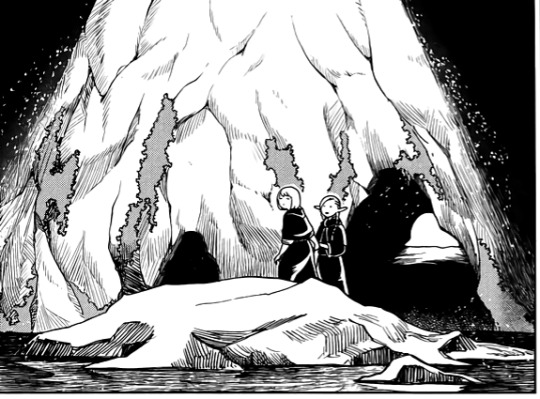
Continuing bellow the cut, Major Spoilers ahead
In ch87 we learn that man-made Dungeons were created by the ancient civilizations to contain the Demon's powers, and be able to better use it.
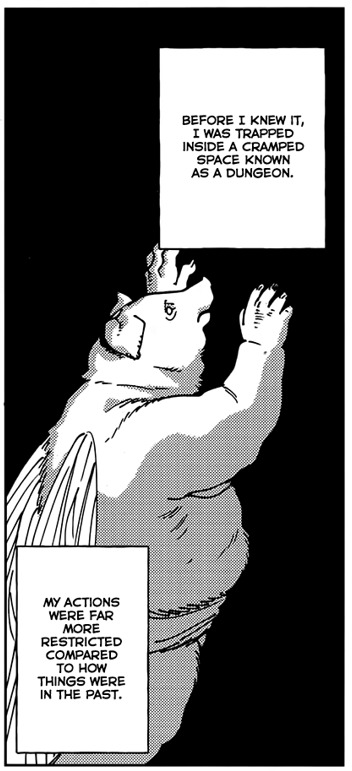
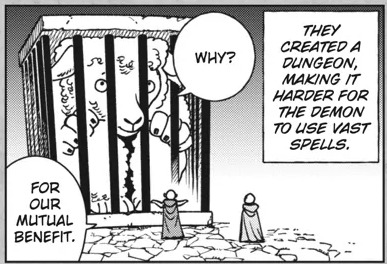
In ch 68 Thistle confirms something similar.

With this in mind, Dungeons also seem to have "Styles".
Like these examples from the cover of ch 48.
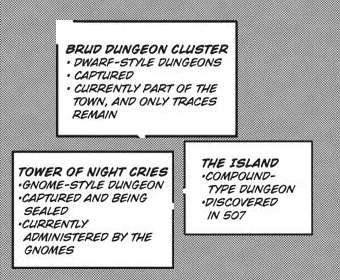
"The island", which is the name given to the Dungeon Linked to Melini Village's Graveyard, is a "Compound-Style Dungeon" while other dungeons seem to have specific styles linked to other ancient civilizations (Dwarf-Style, Gnome-Style, Elf-Style)
'The Island' in specific seem to be a Compound Style between dwarfish and elvish styles. As Thistle says, continuing in ch 68, it was an ancient Dwarf construction that was then used by Elves.
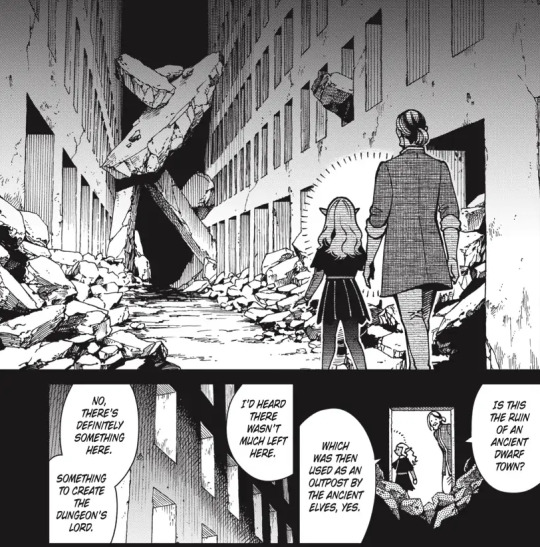
Maybe that's the reason the dwarfish inscriptions are only in the innermost levels of the dungeon. The Style then seems to indicate which ancient civilizations created the manmade Dungeon.
From how they speak about Dungeons in the story I also believe there isn't a way to create new manmade dungeons, and rather they must find them since they were buried by ancient civilizations once they realized it was impossible to control the Demon.
Besides that dungeons apparently also seem to have a life cycle, or "Maturity Levels", that ends with the collapse of the dungeon. Here's the cover for ch 54 illustrating it.
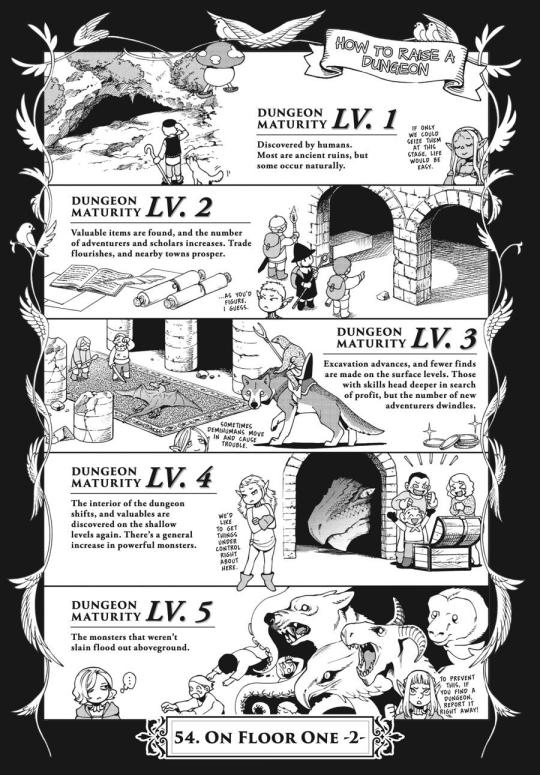
From the descriptions, Utaya seems to have reached lv 5 while others tend to be conquered and collapsed before. Some even seem to collapse on their own.
These are the main Dungeons pointed out in the adventurer's bible with their respective descriptions.
DUNGEONS

1 THE ISLAND
A new dungeon that was discovered just six years ago. It's rumored that the Golden Country that existed a thousand years ago still lies in its depths, imprisoned there by the Lunatic Magician.
2 BUDOU PIT
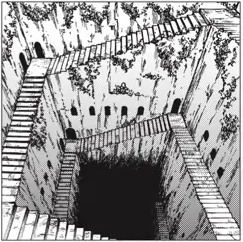
A dwarf-style dungeon. It was excavated straight down like a mine shaft and has already collapsed. Its atmosphere and location are bad, and even after it was discovered, not many adventurers visited it. As a result, it's believed to have collapsed naturally. Its depths may be connected to the ocean: If you listen carefully, some say you can hear the waves. People also claim that if you throw something into the pit, it will inevitably wash up in the port of Kahka Brud.
3 THE BRUD DUNGEON CLUSTER
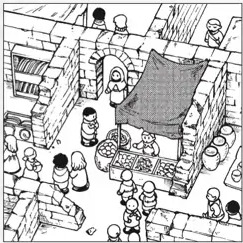
A dwarf-style dungeon. It's made of the ruins of dungeons that riddled the ground beneath Kahka Brud. Now that its last lord has been defeated, the dungeon has been completely captured. It's become part of the town, and bits of it are used as storehouses, shops, and private homes.
4 THE TOWER OF NIGHT CRIES

A gnome-style dungeon. It's on the verge of collapsing and is currently sealed. Since it's still functioning, if barely, it's believed to have a lord somewhere. The dungeon is shaped like a tower. Its name comes from the wailing noise produced by the wind blowing through holes in its walls at night. Winged monsters have been sighted flying around the tower.
5 THE UTAYA DUNGEON
An elf-style dungeon. It changed lords frequently, and it's the dungeon that grew the largest after the ancient war. At present, it's sealed. Fifteen years ago, monsters flooded out and destroyed the nearby towns. Because it had expanded so much, it couldn't be blocked off completely, and the Canaries quelled the situation by casting a barrier over the dungeon and the entire surrounding area. Magic users are still permanently stationed there to maintain the barrier.
6 THE DRAGONS' LAIR
An elf-style dungeon. Currently collapsed. A rare case in which an entire region of interlacing canyons became a dungeon. Many dragons lived here once, and it was a notoriously secluded region. However, it was hard just to get to it, the rewards were small, and the dragons were tough. Almost no adventurers visited it, and it's thought to have collapsed naturally. When the population dwindled, mana stopped flowing through it, so the large dragons vanished. However, a few small dragons still live there.
7 THE CENTRAL WATCHTOWER
An elf-style dungeon near the capital of the Western Elves. Currently sealed. Since it hadn't had a lord for a long time, it was believed to be nearly collapsed. Mithrun was dispatched to investigate a nearby rash of disappearances and got taken in.
There's much more to talk about how the dungeons work, especially how it relates to Ancient Magic but I'll leave it for another post in the future. If you have any insights about the information here or if I've missed something important please share!
#Dungeon Meshi#Dungeon Meshi Spoilers#Dungeons#Dungeon Design#The Island#thistle dungeon meshi#dunmeshi thoughts#Its hard to know whats relevant to the dungeons and whats more relevant for ancient magic since they're so linked#I'll try to edit the image ids and make them better later I hope these are ok
813 notes
·
View notes
Text


this is what I have so far of my one-room-a-day megadungeon project The Ziggurat of Sorrow, which I started on March 1st. So far it has 82 rooms drawn and keyed, with the final goal being 365 rooms after a full year. On the right is a sketch of the external structure superimposed on the internal layout :p
A lot of details like doors and internal room structures aren't shown here bc I'm mainly drawing it on a notebook, this digital version is just a rough sketch I use to be able to visualize the whole thing and keep the layout straight since on my notebook I have to split it into several pages.
437 notes
·
View notes
Text
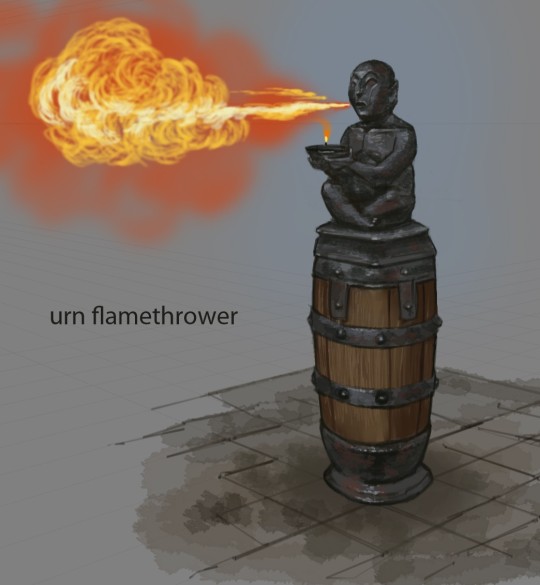
Urn Flamethrower
Concept art for The Elder Scrolls V: Skyrim
Art by Adam Adamowicz
#adam adamowicz#art#the elder scrolls#concept art#tes#skyrim#nord#flamethrower#dungeon trap#dungeon#dungeon design#trap design
244 notes
·
View notes
Text

Dungeon art by Hirotsugu Kaga in homage to Russ Nicholson
343 notes
·
View notes
Text

Drafting the Adventure: To the dungeon!
Recently I worked out a framework for running exploration based adventures , and while a lot of people seemed to like it, a few folks wrote in asking how it might work in practice. I’m only too happy to provide an example, as it will likewise give me the chance to demonstrate how to combine a wilderness adventure with a dungeon adventure, which is something I wanted to do anyway.
Background: the party is sent off to seek an arcane mcguffin contained in an ancient ruin, with the caveat that no one really remembers where the ruin might be. As such they’ll have to explore a stretch of wilderness looking for signs of old habitation before getting to delve the dungeon itself.
Setup: In addition to gearing up The party might want to talk with some locals to get information about where they're going, which will allow you to drop clues about further places they cam explore. Any Entry marked with a (G) can be hinted at in gossip and research, providing them a hint about where to go.
FIRST ZONE : The Ancient Plains
"Cool winds steal the warmth from your cheeks as your party steps into the wilderness, your goal and the mountains far in the distance and a vast rolling grassland before you. This place was the site of a great battle that nearly destroyed your home, but is now quiet save for the murmur of the tallgrass and your own footfalls.
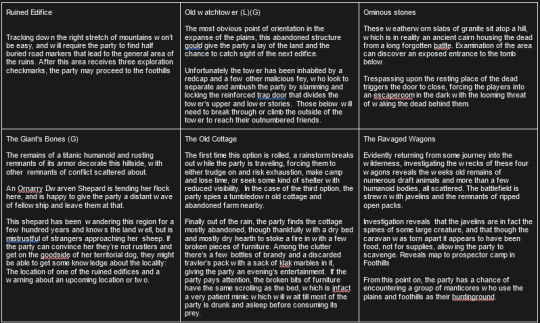
Design Note: The party can either choose to head to one of the locations they've already heard about/discovered, or spend time trying to find a new location with a perception or survival check, with you rolling a die to decide which one to point them at first. Once the random encounter is unlocked, add one die to the pool every time they travel to an area, and two die if their searching for a new area falls below a reasonable dc.
SECOND ZONE: The Forgotten Foothills
"Like the fingers of a grasping titan, the roots of the mountain-range pull at the earth giving rise to steep ascents and sudden valleys. The trickle of pure glacial melt runs in small streams over this uneven landscape, giving you a refreshing if bonechilling respite from your long travels."

Design Note: Now rather than making simple progress, the party needs to actively hunt for the location of the ruins, with the understanding that taking a surface look at different locations is going to bring a random encounter or two down on their heads REAL fast.
Also shoutout to Yithini, my homebrew goddess of ascension in all its forms.
THIRD ZONE: The Cascading Ruins
"It was no wonder it was so hard to find this old fortress, as the waters pouring down from the cliffs above seem intent on wiping it from the mountainside. The noise and the crush of endless water rumbles in your bones as you make your approach, up a slick half eroded stair that might've been part of the structure's battlements. Most of the structure is lost in the pool of rushing white water below, but a few stretches of old fortification still manage to withstand the siege of time. "
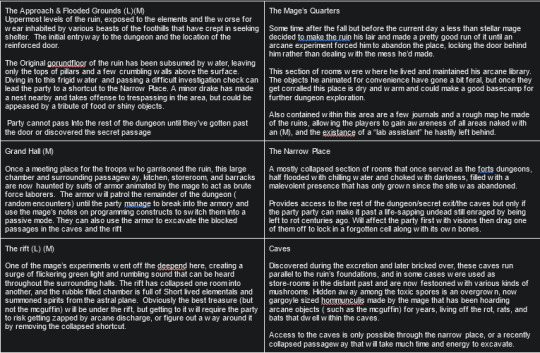
Art
#drafting the adventure#mountain#field#adventure design#dungeon design#dm tip#dm advice#treasure hunt#dungeon#dnd#dungeons and dragons#d&d#ttprg#pathfinder#yithini
195 notes
·
View notes
Text
Shopping Mall Dungeon Design Sucks
(A repost from my Cohost Page)

Brad Kerr has this great summary on the "kinds of DnD" shared on the Between 2 Cairns podcast:
Door DnD: it's about doors! Going through them, figuring out how to open them, wanting the treasure that's behind them, being scared of what's behind them, sometimes fighting what's behind them but you're more likely to run away or try to outsmart them
Fighty DnD: it's about fighting guys! You wanna fight those guys on the other side of the door! You wanna get real strong and use cool abilities and get those sweet +2 modifiers so you can fight things better
Sticky/Messy DnD: you don't care about the doors unless it makes things messier! Success, failure, no! partial success is what it's all about, anything that makes things more messy and tangled! Kiss who you aren't supposed to! Get in trouble! It's messy!
I remember reading bottom-tier advice fodder on twitter that suggested you could use a map such as this as a template for a dungeon. However, there is one key flaw in the design that I have encountered before, and that's the single access corridor that takes you to all the rooms.
I ran a dungeon in ICON last year which was a 5-story staircase with rooms around the sides of the massive central chamber. In the center was an open pit. Two npcs broke into the dungeon as the players opened the door, and the players immediately went down all the stairs to the bottom to the bossfight. It was one of those moments where I had to grit my teeth and accept that emergent storytelling is in fact emergent, and this was fun and cool actually. Now, I know what my failure was. It was making a Shopping Mall Dungeon.
Here are 3 things presented in my own words that stick out to me about the process of a dungeon crawl:
Everything happens "Indoors" where the structure of the place restricts movement
It's tricky to define where someone is when they are in a corridor (revealing their liminality), but you move through corridors quickly and fluidly to get to different rooms
Rooms enclose relatively self-contained ideas for players to interact with, though players are free to subvert this by taking one self-contained idea and using it to influence another (this is intentionally broad, but you can take fire from one room to burn a rope in another).
These three qualities are the criteria of a "Shopping Mall Dungeon" to me. Something so simple ought to be interrogated! As it turns out, having a long corridor is like having one big room, and when that room is the hub for multiple single rooms that only connect to the center, you lose that sense of depth to the dungeon that stokes the magic of the crawl. Instead, you get a list of doors to work through.
And you know, that's what shopping malls are built for. They aren't built for you to solve or navigate. They aren't built for you to explore. They are built with super-wide corridors for maximum imagined traffic and to expose you to as many storefronts as possible. There is no puzzle to it. Only content.
13 notes
·
View notes
Text
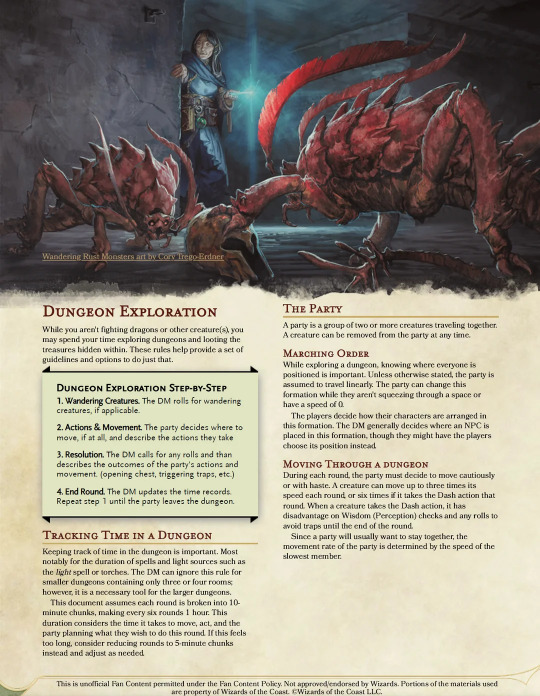
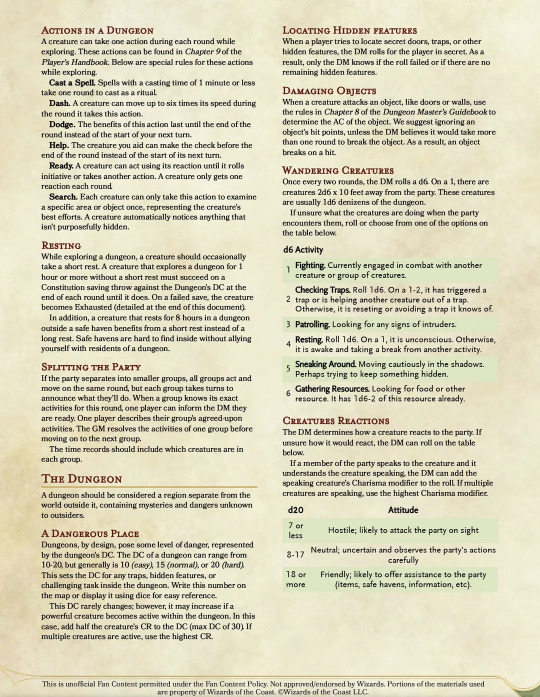
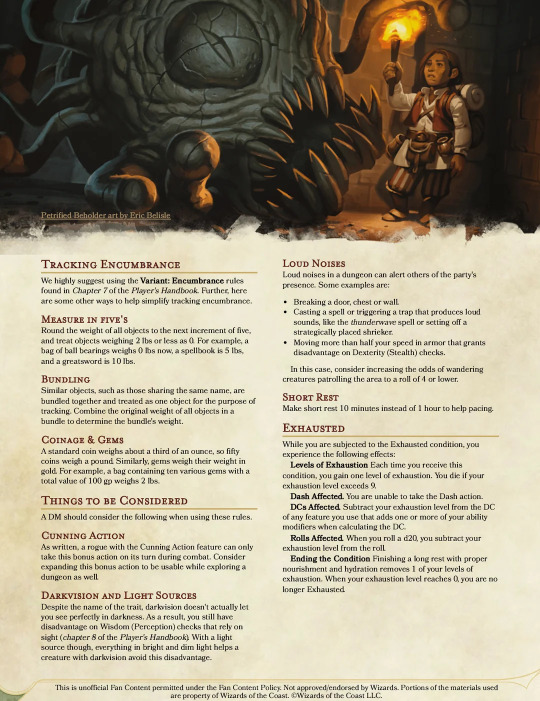
Dungeon exploration by O-kra on reddit
58 notes
·
View notes
Text
Random Dungeon
So the TTRPG I'm designing Abbadon has a number of tools. Random magical affixes for items which I've had plenty of time to play around with. I recently redrafted my random dungeon guidelines and tables for the game and gave it a go last night with a test play. It went pretty well to the point where I'm much happier with this version of the tools as written. It provides a good set of building blocks that can easily be tweaked and added to or run as is on the fly.
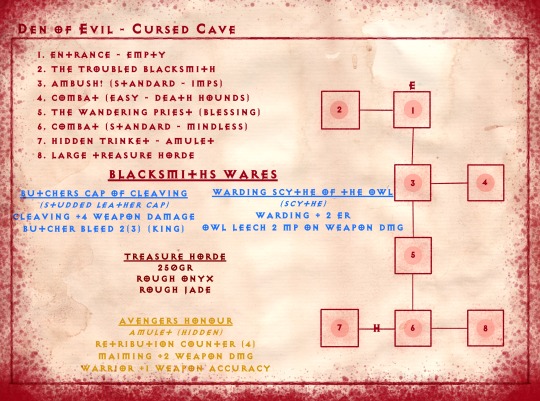
This isn't a super in depth map like you'd maybe find in D&D but it serves the purpose and feels more like a simplified Darkest Dungeon map with the corridors and random encounters there in removed and only focused on the rooms. Deciding which directions to branch from are up the GM or players if you're generating the dungeon collaboratively (Which I've also tried in test plays for a lot of fun)
No hazards were generated such as traps or environmental hazards but you can see that 2 non combat encounters were generated which have mechanical things players can interact with, 3 combat encounters where generated one being an ambush and one being an easy encounter. The book has streamlined rules for balancing encounters that's based on the spent experience of the party and party size.
Some sizable loot without needing a fight as well as a really good hidden piece of treasure were generated as well (Sadly the party didn't find the amulet it would have been a nice addition to the Faithful or Stalker most likely)

#ttrpg#ttrpgs#indie ttrpg#ttrpg design#ttrpg stuff#ttrpg community#kickstarter campaign#dungeon design
29 notes
·
View notes
Text
Dungeon Appreciation Post #4 - Womb of Grief (Shin Megami Tensei: Strange Journey Redux)
I mean, just look at this thing. The scale of the optional extra dungeon in SMT: SJR is something I aspire to. I mean, the original game came out for Nintendo DS in 2009, the remake (and thus this dungeon) in 2017, but the design here is truly old school.
While the dungeon itself is super recent, it follows the general design of dungeons in the main game, which is to fill just about as much of the map grid as possible on each floor, except this one has seven, and you return to it, going deeper each time as you go through the main story. Typically, you go to a lower floor and eventually open a shortcut to the one above so that you can return more easily.

The Womb of Grief makes heavy use of conveyor floor tiles and teleporter tiles with unclear destinations, classic but controversial elements in DRPGs, some say outdated. Strange Journey was notable for throwing back to these designs that have in some ways fell out of fashion, but they are classic confusion tactics. My first experience with both of these was Pokemon Blue, with conveyor tiles in the Celadon Game Corner and teleporters in Sabrina's Gym. It also has some invisible floors, and pit traps that can take you to an unfamiliar part of a lower floor. It's main characteristic is that it's huge and very difficult to traverse, and is so despite having the map fill in as you go.
In a simpler game like Pokemon, similar traps present no real problem, but are a nod to the games that inspired them both, but in the Womb of Grief, though you map the dungeon out and can try paths you haven't yet tried, the complexity is cranked to such a level that you can have a hard time keeping track of where teleporters lead that you definitely have already been through, just because there are so many to keep track of. There's also a floor where teleporters have multiple destinations depending on the order you used them in. Both enemy encounters and poison and sleep tiles will drag and punish your failures of memory and mapping, which you might need to do on paper.
Takeaways for my own game: The Womb of Grief upsets players. It's beautiful. Strange Journey directly inspired my decision to make a dungeon crawler. But, I don't want my own game to feel as oppressive, necessarily, that requires trust from the players that I as an unknown will not have. However, I do love a sprawling dungeon that feels dangerous and uncharted. I'm not necessarily as interested in having a dungeon fill literally all available space to the point it loses a readable form, but mine will have verticality, so there's a ton of space to play with layout. I don't have to use traditional conveyor tiles, but what about a slide? It's already possible to fall off ledges, so why not have pitfalls and leaps of faith? I do want the spaces to feel real and take advantage of three dimensions, which is where the intertwined maps of Dark Souls (the first) might guide me. I'm considering having the bulk of the game take place in one mega-dungeon, so I'm looking for ways to add variety within it. In that sense shortcuts to different sectors as a progression mechanic will be a must.
#game design#rpg#jrpg#dungeon design#dungeons#dungeon map#video games#rpg design#shin megami tensei#strange journey#smt strange journey
9 notes
·
View notes
Text
Dungeon 23, Month of September, the Kobold Fortress

13 notes
·
View notes
Text
Try these puzzle ideas for your D&D / TTRPG adventures.
#Puzzles#D&D#DnD#Dungeons and Dragons#TTRPG#Tabletop#RPGs#Roleplaying Games#Dungeon Master#Game Master#Dungeon Design
8 notes
·
View notes
Text

Kudos to the authors of the 6th Ed Warhammer Fantasy Tomb Kings army book for just putting a whole darn dungeon in here... modern GW would never :((
3 notes
·
View notes
Text
Small-ish dungeon I whipped together in a couple days for my seven-day dungeon jam.


Designed for bastards. by Micah Anderson, but everything is described in a pretty system-agnostic way, so it should be easily compatible with any old-school dungeon game.
179 notes
·
View notes
Text
Encounter concept: your party goes into the local Goblin cave and, due to the volume of adventurers that the village has been sending after them, they have hired a Cavern Secretary to manage appointments for raids and counter-raids.
Your party has to find a way to negotiate an appointment with the Cavern Secretary that'll allow them to attack the Goblins before they do their big siege in the next few days, otherwise the village will be lost.
11K notes
·
View notes
Text

Dungeon design tips: the balance between flair and function - blog post by Paths Peculiar
44 notes
·
View notes
Text


ah my favorite zelda game *looks at smudged writing on my hand* Wind Baker
#I had no idea I could style match this. good to know I guess#dungeon meshi#legend of zelda#loz#wind waker#laios touden#chilchuck tims#senshi of izganda#marcille donato#my art#character design
50K notes
·
View notes